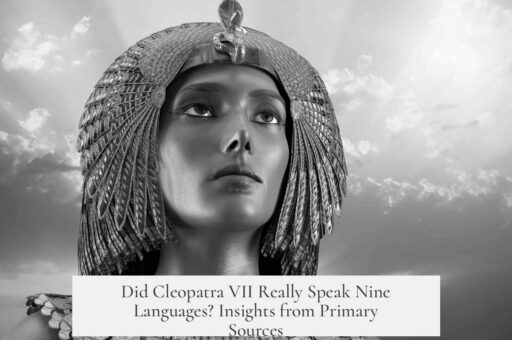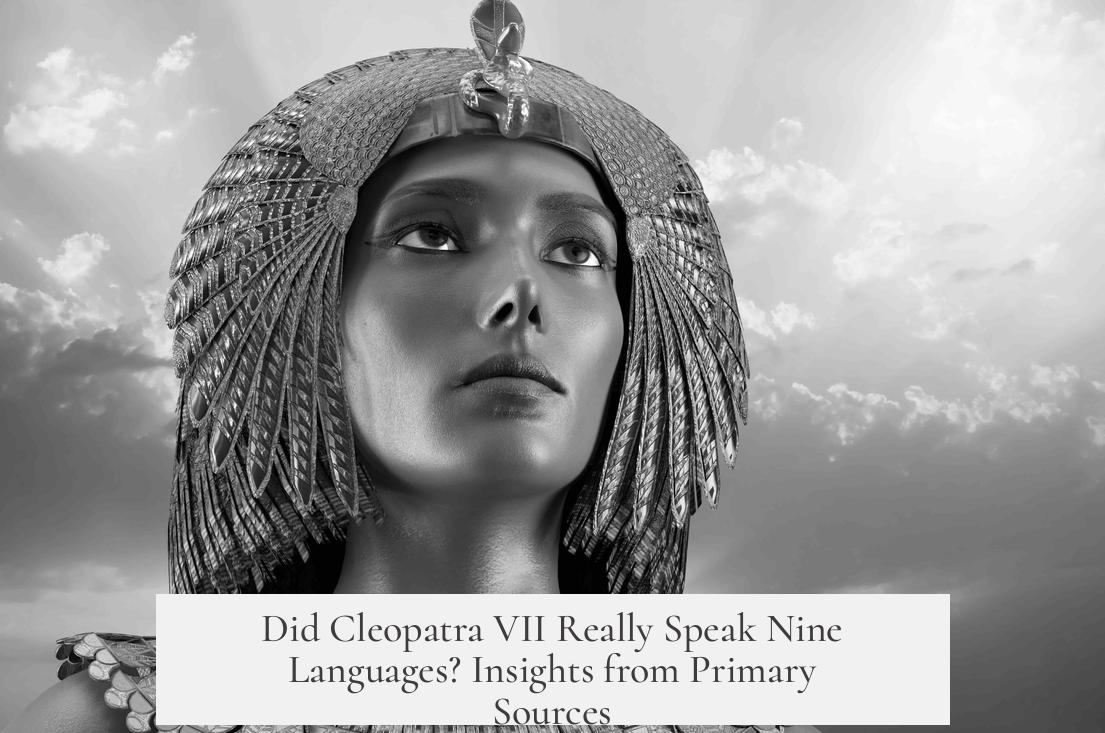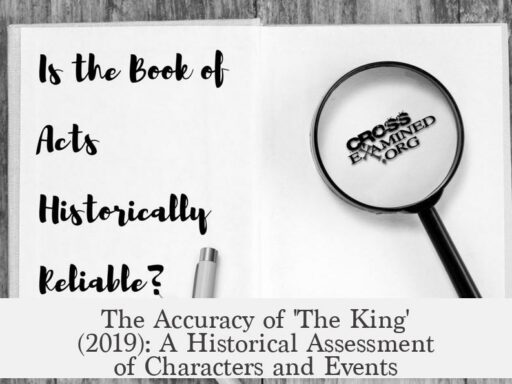Cleopatra VII did not definitively speak nine languages fluently; this claim mainly arises from a single ancient source, Plutarch, who suggests she knew multiple tongues. The exact number and fluency in nine distinct languages lack solid primary source evidence.
Plutarch, writing centuries after Cleopatra’s death, provides the most direct account of her linguistic skills. In his Life of Antony, he describes her “tongue like a many-stringed instrument” that she could turn to speak several languages. He lists peoples such as Ethiopians, Troglodytes, Hebrews, Arabians, Syrians, Medes, and Parthians whom she addressed without an interpreter, implying multilingual ability.
However, Plutarch does not specify precise languages but names ethnic or regional groups. Scholars caution that these names do not correspond neatly to nine distinct languages. For example, “Troglodytes” refers to a loosely defined group, not a language; “Ethiopian” likely points to languages like Ge’ez or Meroitic; “Hebrews” would have spoken Aramaic or Hebrew, with Aramaic being the diplomatic lingua franca of the time.
| People Group | Likely Language(s) | Notes |
|---|---|---|
| Greeks | Koine Greek | Native tongue and court language |
| Egyptians | Demotic or early Coptic Egyptian | Cleopatra was the first Ptolemaic ruler to learn Egyptian |
| Syrians, Hebrews | Aramaic | Widely used diplomatic language |
| Arabians | South Arabian dialects (e.g., Ge’ez, Safaitic) | Regional trade languages near the Red Sea |
| Medes, Parthians | Old Persian dialects | Related Iranian languages |
This suggests Cleopatra probably spoke at least five key languages or dialects to varying degrees of fluency. Greek was her native language and used in court. She uniquely mastered Egyptian among Ptolemies, which was significant for ruling a predominantly Egyptian population. Aramaic and Old Persian dialects were useful for diplomacy and dealings with neighboring powers.
Some secondary languages like Latin were possibly known at a basic conversational level, but Cleopatra’s fluent use remains doubtful. Latin was the language of Roman elites, whom she dealt with politically. Hebrew was likely not spoken by her; Aramaic was far more common among Jewish communities and officials. Languages attributed to groups like “Troglodytes” remain unknown, possibly local dialects.
Historians argue the number nine may be an exaggeration drawn from listing ethnic groups rather than individual languages. Fluent mastery of nine unrelated languages by any ruler—ancient or modern—is rare. More plausible is that Cleopatra used a combination of fluency, comprehension, and ceremonial phrases to communicate across cultures.
The confusion arises partly because ancient sources often list peoples rather than languages. Linguistic families cluster some of these groups, such as the Semitic languages (Hebrew, Aramaic, Syriac) or related Iranian languages (Median, Parthian). Similar languages could be learned more easily by a multilingual speaker.
Other ancient rulers, like King Šulgi or Yariri, boasted knowledge of multiple languages, which was a known marker of elite education and diplomatic skill. Cleopatra’s reputed multilingualism aligns with this tradition but must be understood within realistic limits.
Modern sources sometimes inaccurately claim Cleopatra spoke “Old Arabic.” This is chronologically implausible; Old Arabic inscriptions postdate Cleopatra by over a century. Such errors stem from misreading ethnic terms or overextending ancient designations.
In summary, Cleopatra’s linguistic abilities were real but remain documented only by Plutarch’s account. She likely was fluent in Greek and Egyptian, proficient in several regional languages for political and diplomatic use, but the claim that she spoke nine languages fluently is unsubstantiated by primary sources.
- Plutarch’s Life of Antony is the sole direct ancient source mentioning Cleopatra’s language skills.
- She probably spoke Greek (Koine), Egyptian, Aramaic, some Persian dialect(s), and South Arabian dialect(s).
- The “nine languages” claim arises from interpreting ethnic groups as individual languages.
- Other languages like Latin or Hebrew were likely known only superficially.
- Multilingualism enhanced her diplomacy rather than reflected equal fluency in many tongues.
Did Cleopatra VII Really Speak 9 Languages? Unpacking the Primary Sources
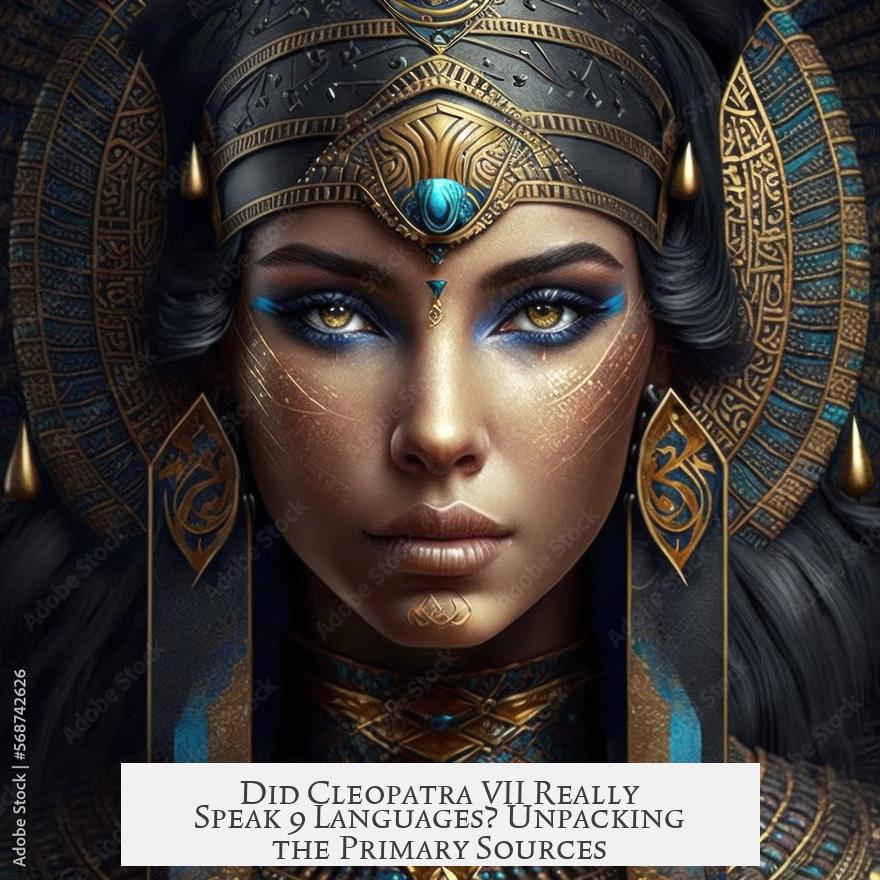
Cleopatra VII, the last active ruler of the Ptolemaic Kingdom of Egypt, is often legendary not just for her beauty and political acumen but also for her linguistic talents. But the tantalizing claim that she spoke nine languages—does it hold up under scrutiny? The straight answer is: The evidence suggests Cleopatra was indeed multilingual, likely speaking five or more languages, but the exact claim of nine fully fluent languages comes mainly from a loose interpretation of ancient texts, primarily from Plutarch, without solid contemporary proof.
Let’s wade through the ancient fog and modern analysis to see what language Cleopatra really spoke and how this myth evolved.
Primary Source: Plutarch’s Account
The main, actually the only primary historical source that boldly champions Cleopatra’s linguistic prowess is Plutarch’s Life of Antony, written centuries after her era. Plutarch describes her tongue “like a many-stringed instrument” capable of switching languages at will. He specifically recounts Cleopatra dealing directly with various peoples—Ethiopians, Troglodytes, Hebrews, Arabians, Syrians, Medes, and Parthians—often without an interpreter.
“Pleasure also came with the tone of her voice; and her tongue was like a many-stringed instrument: she could turn it easily to whichever language she wished and she conversed with few barbarians entirely through an interpreter, and she gave her decisions herself to most of them, including Ethiopians, Troglodytes, Hebrews, Arabians, Syrians, Medes, and Parthians.” — Plutarch, Life of Antony
That sounds impressive, right? But a giant caveat here: Plutarch wrote around the 1st and 2nd centuries AD, at least 200 years after Cleopatra’s death. He never lists exact languages—just peoples. And remember, Roman-era biographies often mixed fact with political agendas or personal flair, especially with a figure as controversial as Cleopatra.
But Did Cleopatra Speak Nine Full Languages?
It’s a stretch to say she flawlessly mastered each language of the groups Plutarch mentions. Scholars today note that Plutarch’s “nine languages” is mostly an extrapolation of his ethnic list rather than a neat linguistic catalog. For instance, “Troglodytes” refers to a general group of people, not a known language. Similarly, “Hebrews” likely implies Aramaic rather than Hebrew itself, since Aramaic was the lingua franca Jews spoke at the time.
Modern analysis suggests Cleopatra’s linguistic abilities were exceptional but had practical political limits. She probably spoke Greek fluently, as it was the court’s official language. Unique among Ptolemaic rulers, she also learned Egyptian (Demotic or early Coptic), which helped her connect with native Egyptians. Then comes a diplomatic lineup:
- Aramaic: Widely spoken in the Near East, a diplomatic lingua franca.
- South Arabian Dialects: Possibly Ge’ez or Safaitic, used among Arabian peoples near the Red Sea.
- Old Persian Dialects: Median and Parthian languages were likely part of political dealings.
To round out the probable list, she may have known basic Latin to communicate with Roman elites, though fluency is doubtful.
Table of Likely Languages Cleopatra Knew
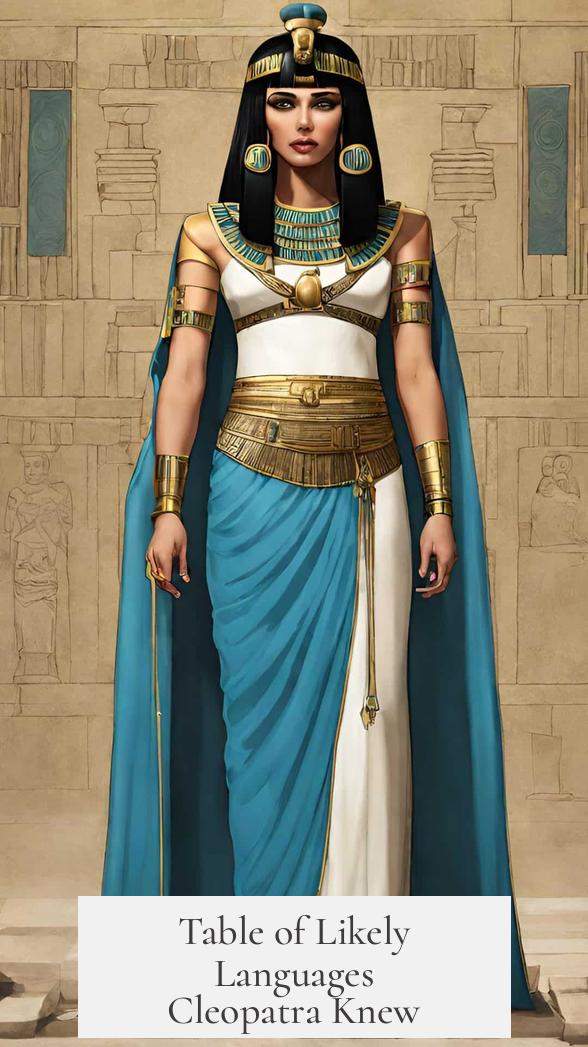
| Language/Dialect | Comments | Likelihood |
|---|---|---|
| Greek (Koine) | Native tongue, primary court language | Confirmed |
| Egyptian (Demotic/Coptic) | First Ptolemaic to speak the native language | Confirmed |
| Aramaic | Common diplomatic language in Near East | Probable |
| Old Persian dialects (Median/Parthian) | Political relations with Persian neighbors | Possible |
| South Arabian dialects (Ge’ez/Safaitic) | Communication with Arabian tribes | Possible |
| Latin | Language of Roman elites, possible basic knowledge | Possible, but not fluent |
| Hebrew | More likely she spoke Aramaic instead | Unlikely |
| Nubian/Meroitic | Neighboring languages, perhaps minimal knowledge | Unlikely |
| “Troglodyte” language | Unknown; term vague | Unknown |
Why Does Language Confusion Occur?
Many ancient ethnic names don’t neatly map to one language. “Arabians” versus “Arabic,” for instance, shows how people groups can be mistaken for language groups. Hebrew and Aramaic were closely related Semitic languages, often conflated in texts. Similarly, Median and Parthian are Iranian dialects rather than completely separate languages. Cleopatra’s ability to communicate likely involved code-switching between closely related dialects rather than being a hyperpolyglot of vastly different tongues.
As one Reddit historian commentator notes, learning languages within a family is easier, much like a Dutch speaker picking up German and English. So Cleopatra’s multilingualism was impressive but more plausible within the Semitic, Iranian, and Hellenistic linguistic families.
What About Other Multilingual Rulers?
Cleopatra was not a linguistic unicorn. Ancient rulers often boasted impressive languages skills. King Šulgi of Ur, circa the 21st century BCE, claimed knowledge of five languages. Regent Yariri of Carchemish in the 8th century BCE famously knew twelve tongues. Multilingualism was a tool of diplomacy and administration, not merely a personal charm.
Cleopatra’s skill set was pragmatic. Knowing Greek and Egyptian connected her culturally. Adding Aramaic and Persian dialects helped diplomacy with Near Eastern neighbors. South Arabian dialects smoothed Red Sea relations. Even knowing some Latin would bridge ties to Rome. The ability to greet dignitaries with their language—whether with complete fluency or ceremonial phrases—boosted her political image.
Why Do Many Believe She Spoke Exactly Nine Languages?
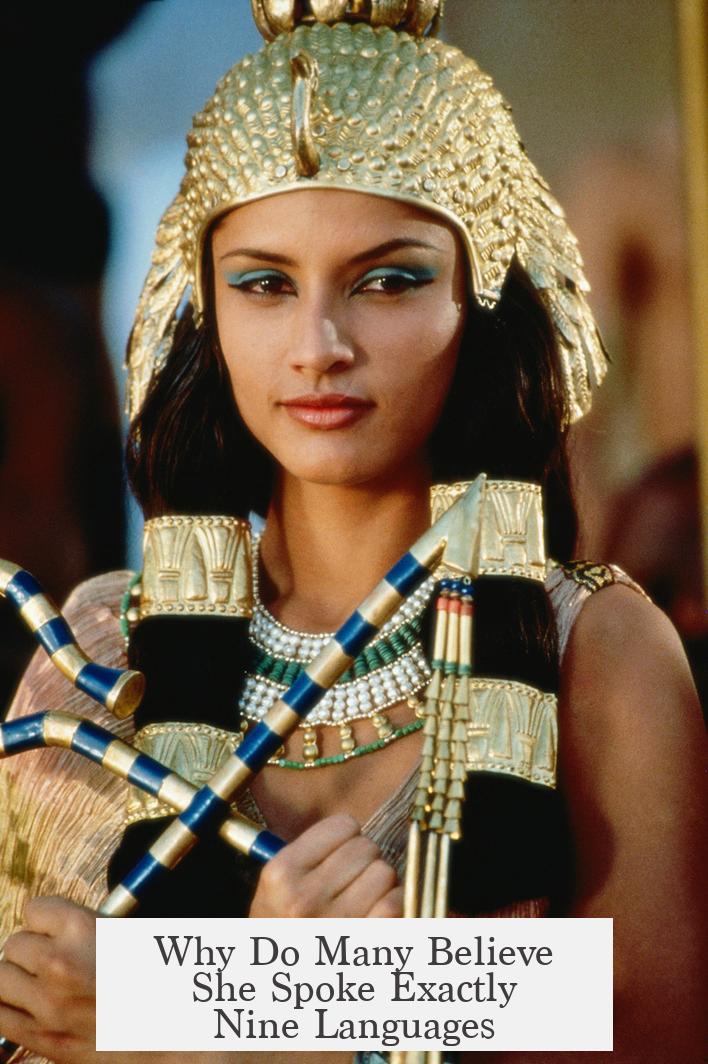
The “nine-language” figure seems to stem from an over-literal reading of Plutarch’s ethnic list and later medieval or modern embellishments. Wikipedia entries sometimes add “Old Arabic” to the list, but this is an anachronism since Old Arabic appears centuries after Cleopatra’s time. Confusion between peoples and languages, combined with later romanticism about Cleopatra, helped inflate her linguistic legend.
So, What’s the Reality?
If you want a realistic take, Cleopatra was certainly a highly educated, multilingual monarch. She spoke Greek fluently, uniquely embraced Egyptian language, and managed to converse diplomatically in Aramaic and possibly some Persian and South Arabian dialects. Her political savvy meant she didn’t need perfect fluency in nine unconnected languages to impress or lead effectively. Mastery in five to six languages, plus some cultural languages, seems more credible.
After all, wouldn’t you rather charm foreign diplomats with perfectly sound Greek and Egyptian rather than attempt too many tongues and risk sounding like a confused tourist? Cleopatra used language as a tool, not a circus act.
Practical Lessons from Cleopatra’s Multilingualism
- Understand your audience: She learned Egyptian to legitimize her rule to native subjects.
- Political dividends of language: Speaking to diplomats in their own tongue gained trust.
- Multilingualism is a spectrum: You don’t need to be Shakespeare-level fluent in all languages to succeed—practical basics often suffice.
In Conclusion
Cleopatra’s linguistic talents are legendary but should be seen through a critical lens. Plutarch’s account remains the sole primary source citing her polyglot nature, but he doesn’t claim nine specific languages outright, only a variety of peoples. Modern assessments suggest she was a brilliant, pragmatic multilingual ruler who spoke at least five key languages fluently or conversationally, with knowledge or ceremonial skills in a few more.
This level of linguistic talent was exceptional in her time and undoubtedly helped her navigate the treacherous waters of Hellenistic geopolitics. So next time someone claims Cleopatra casually whipped out nine languages, remember: it’s a compelling legend, but real language skills are often far more nuanced and practical.
Cleopatra’s real genius was never just words—it was the power behind them.
